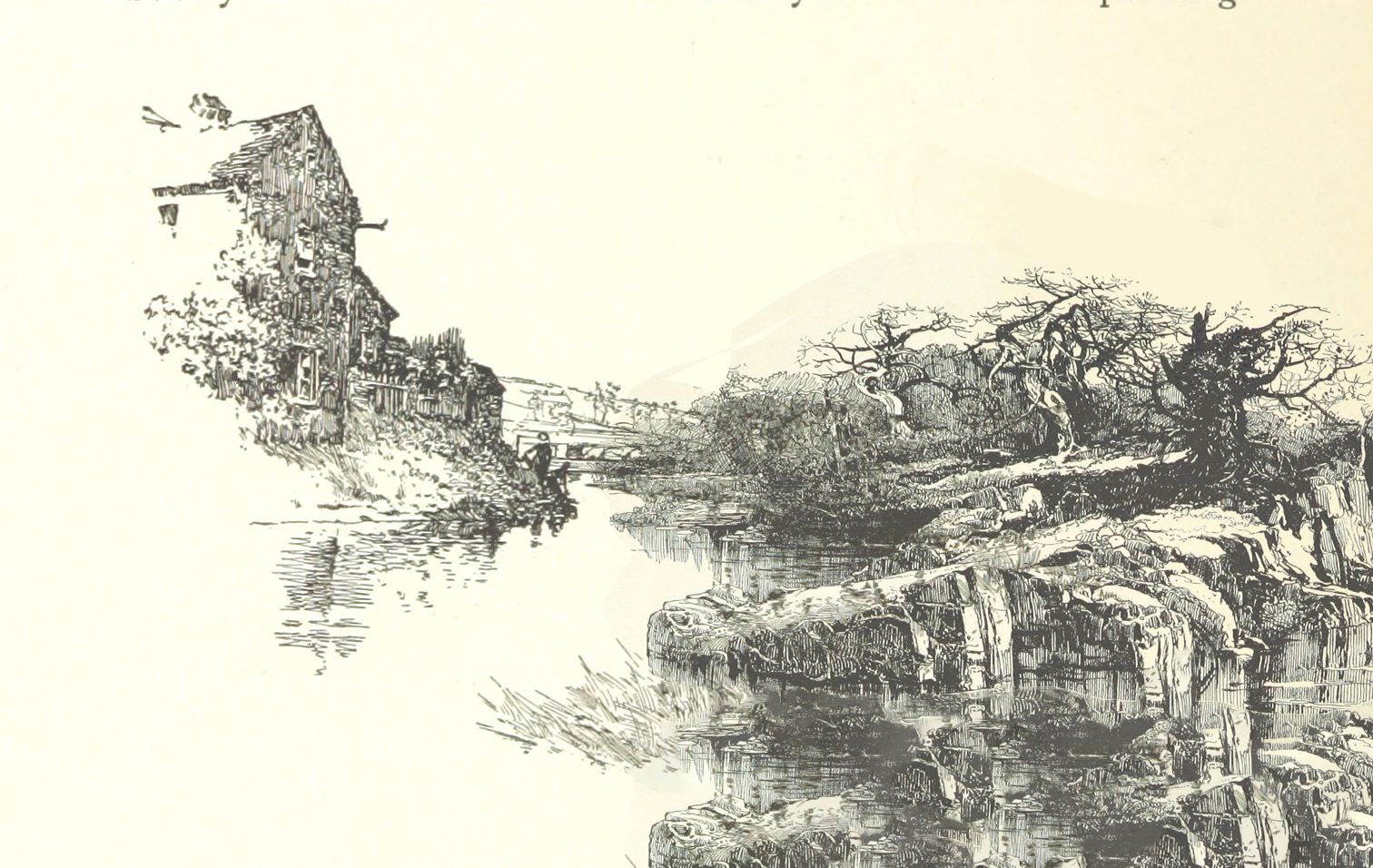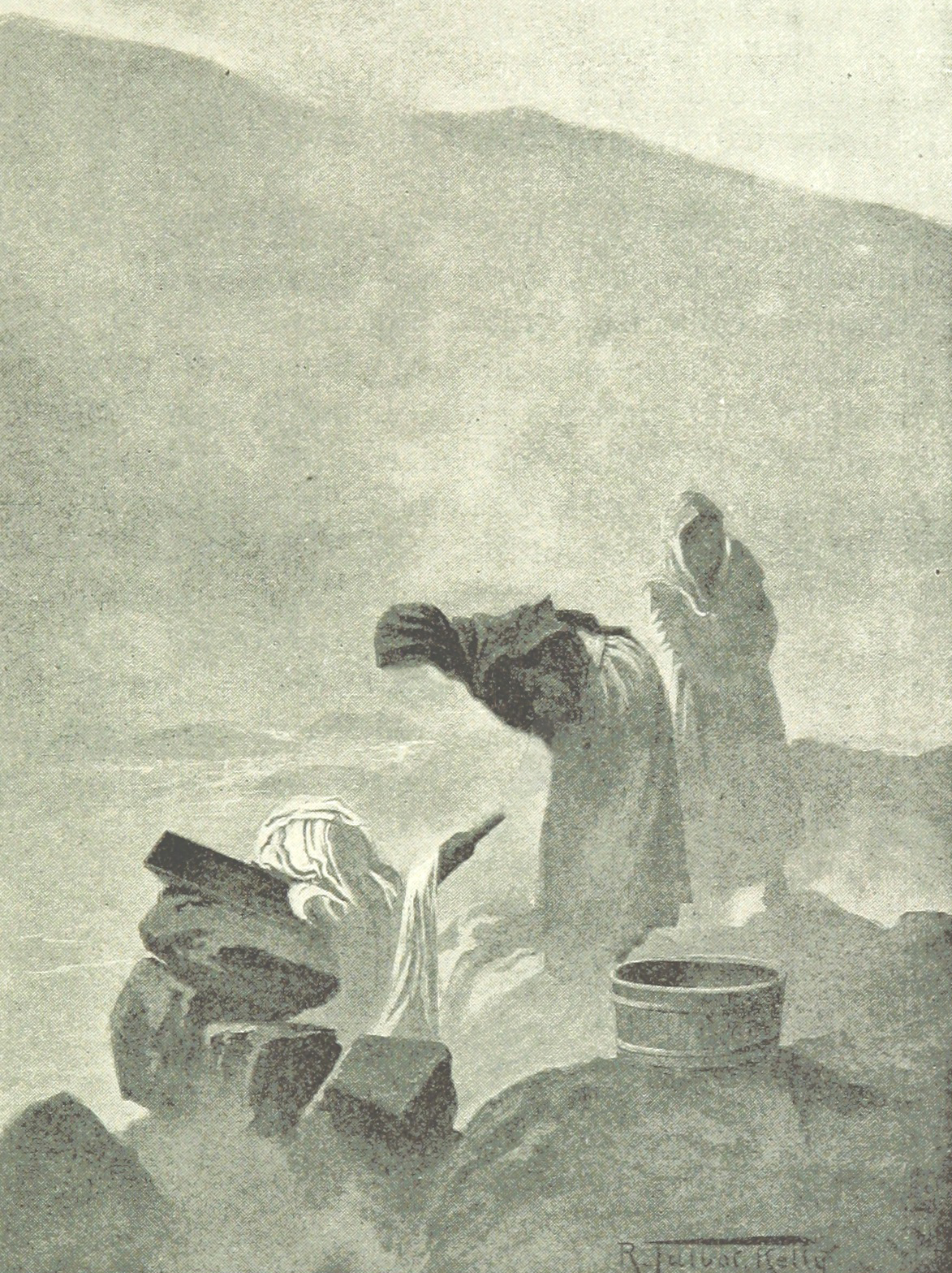The Village of Sirtol
This is the first of a series of posts describing a small riverside village (which once a year becomes a pilgrimage destination) and the surrounding areas. The settlement is split in two parts by a large chasm; this separation is also mirrored in the unusual social stratification of the population. In my setting the village is on the edge of a large forest, climbing on the foot of some wooded hills, in a secluded valley far from any sizable human civilization – the whole valley is very strongly influenced by real world animistic beliefs. (As a sidenote, the village’s name is a reference to the city of Sirtel, from the namesake Slauter Xstroyes song)
 On the north shores of river Dubul, looking west. On the left can be seen one of Banks’ houses.
On the north shores of river Dubul, looking west. On the left can be seen one of Banks’ houses.
Facts about the village:
- The village is split in 2 parts: a riverside (Banks) and an uphill one (Slopes). Between them lies a (10m wide, 1km long) chasm of unknown depth; this is called the Mouth. The settlement is bordered by the river Dubul on its north and western sides.
- Once per year, vapors rise out of the Mouth for two weeks (always from a New Moon to a Full Moon). When this happens, pilgrims come: the villagers help them to descend with ropes (they are sacred ropes made of tree fibers and corpse hair) and sleep in small crevices on the upper chasm walls to get prophetic (and other kind of interesting) dreams – alas, some dreams are nightmares. Most of the pilgrims return to the surface.
- The villagers, due to their permanently living in the area, are unaffected by the vapors. Some of them have slightly prophetic abilities (they frequently get glimpses of next day’s events or sometimes of something more distant in time).
- The village population, mainly human with halfling clusters, has an unusually high number of twins. Twinship is the axis upon which the village is organized: Slopes is home to all non-twins, as well as the younger twins (those that exited last from the uterus). Banks is where all elder twins reside – they control the dock and maritime communication.
- The population has remained roughly the same for the past two centuries ~ slightly less than 300 persons.
- Almost no metal. Most things (weapons and armors included) are made of wood, bone, horn, earth, clay, scales, and other nature-occurring materials.
 Rough preliminary sketch of Sirtol village
Rough preliminary sketch of Sirtol village
Slopes:
- Roughly 30 single-floor houses spread over 20 square minutes.
- Buildings have thick (2m wide) rounded adobe walls. The extreme thickness is due to the following burial custom: after decomposition, the bones of the dead are inserted in the house walls and covered with adobe mud.
- Roofs are thatched and very wide, reinforced with hair of the aforementioned dead. Thus they become unnaturally sturdy, water- and heat-proof.
- A bell chime from the temple of Fliria (goddess of the eastern fields) in the east end marks sunrise, while sundown is signaled by a gong sound from the shrine of Dubul (the namesake river-god) in the west end.
- Slopes smell of earth, manure and hearth smoke (hearth fires burn almost throughout the year).
- Domesticated animals include mostly hens, a few goats (for milk and hair), and semi-domesticated pigs which graze in the forested hills to the south and southeast. The swine may occasionally attack and eat a child or very frail person that wanders alone in their territory. Those pigs that dine on human flesh are able to move on the spectral paths of the dead.
Banks:
- 15 houses, two- or three-storied, made of dark (almost black) wood. They have sloped roofs, covered with stone tiles (which are pretty stable, though it is not unheard of for some passerby to die due to a tile falling to his head – they are considered chosen by the winds, and are taken south, to the nearest mountaintop, and left there).
- Banks smells of river and dump, of hearth smoke, and of sweet bread (this is an oddity due to a paradoxical property of the earth beneath the particular area).
- Semi-domesticated animals include otters and ducks.
- Banks has a hollow tree-like rock. Inside there are steps descending to a small cave whose walls are mirror-like. Therein are kept the sacred ropes that are used to lower the pilgrims to the chasm.
- At four points of Banks there are the remains of a stone-paved road. It seems that at some era it connected the chasm to the river and beyond. The people will take great pains to avoid stepping on any of these parts.
The Mouth:
- It is taboo to bridge the chasm in any way. The villagers will actively hunt down anyone trying it. The same goes for any attempt to place a fence.
- During its steaming time, the Mouth’s vapors thicken each day. During the last night, when it is full-moon, the fog is so thick that nothing can be seen beyond half a meter.
- There is a natural spring on the western edge of the Mouth, emptying in the chasm. Its water tastes like wet cotton.
 Typical village scene when a hunt is under way
Typical village scene when a hunt is under way
Seven Scenes:
1. A procession of yellow-clothed villagers carry the body of a young man up to the hills, to release it to the winds.
2. Under a horned moon, a trio of naked old women drive a wooden plowshare through the fields to bless the earth.
3. Children chipping at their house’s (extremely thick) walls reveal a skeletal hand; the palm holds a clay eyeball-sized sphere.
4. Someone is whipping his shadow, on the wall of a house.
5. Villagers return from the monthly forest hunt, their bounty plentiful, though their eyes are clouded by grief – three of their numbers were claimed by the forest. A feast is joined by both village sides.
6. At night, halflings are seen in their gardens, their feet immersed in the moist earth, eyes star-gazing.
7. Scarecrow-like figures made of garments can be seen throughout the village, both outside and inside the houses. The clothes that form them seem to be in good condition. (Before embarking for the hunt, the villagers leave their normal clothes at their houses. They place them so as they resemble human figures – empty clothes sitting upon chairs, lying on the beds, standing in the garden. They want to trick the animal spirits into believing that they are still at the village.)
Five Adventure Seeds:
1. A halfling woman seeks help – her only daughter has disappeared in the forest, where she had gone the night before last, as it is customary for all Sirtolian girls to spend the night before their 13th birthday at the forest. [If they ask around the PCs will learn that the girl was way taller than any halfling. There are rumors that her parents adopted a human child or a hag spawn.]
2. A woman with newborn twins seeks help – her husband has been burning small animals to their hearth for the past days, and now she’s worried that he will sacrifice the twins to the flames. [He is trying to burn the mortality out of the creatures that he immolates, making them immortal. All this is according to knowledge he gathered from a tower across the river, just an hour deep in the forest.]
3. Vapors emerge from the chasm, thicker than ever. But the ropes of lowering have vanished!
4. The gong of Dubul’s shrine has disappeared and sunset refuses to come.
5. Last week there was a large storytelling gathering at Banks. Since then, two creatures from the story have been rumored to roam the village at night: a leper and a horned snake.